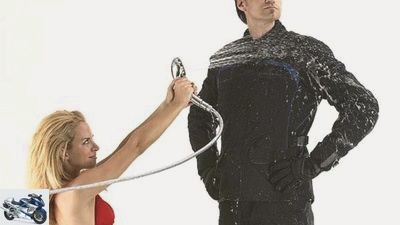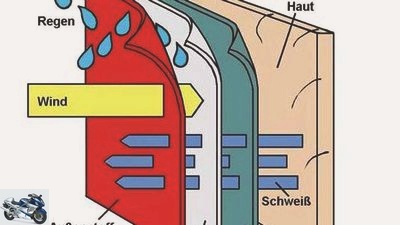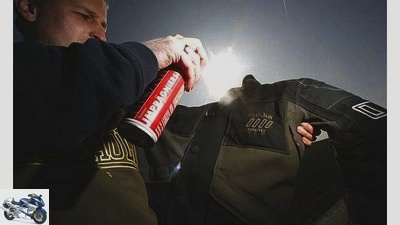Table of contents
- Basics of climate membranes Manufacture and function of different membranes
- story
- Checkpoints
- construction
- Suit regulations
- Wash & Go

fact
counselor
workshop
Everything about climate membranes
Basics of climate membranes
Manufacture and function of different membranes
Water doesn’t get in, but water vapor comes out – in principle, climate membranes are a simple matter. Or maybe not.
06/08/2009
The best known is the microporous membrane from Gore-Tex. This is made of polytetrafluoroethylene, or PTFE for short, also known under the trade name Teflon. In the manufacturing process, the wafer-thin material is stretched (“stretching process”) in such a way that a fine sponge or hedge structure is formed and the film has microscopic pores, so to speak. Calculated on the square centimeter, there are around 1.4 billion such pores. These are around 700 times larger than a water vapor molecule, so that sweat can evaporate through the membrane. On the other hand, the pores are 20,000 times smaller than a drop of water, which is why rain literally pearls off the film. Since PTFE is water-repellent, it cannot soak up moisture in the form of rain or sweat.
The second functional principle is the pore-free compact membrane, the best-known representative of which is sold under the trade name Sympatex. Functional principle here: The membrane itself is also water-repellent (“hydrophobic”), but has a water-attracting (“hydrophilic”) structure. This can now absorb the water vapor molecules that arise when sweating and transport them to the outside. The raindrops, which are many times larger, fail because of the water-repellent surface. The starting material for this membrane, which is also only a few hundredths of a millimeter thick, is either polyurethane (PU) or polyester (PE), depending on the manufacturer. Both functional principles require a pressure gradient between the inside and outside of the membrane. The water vapor molecules are passed through the membrane in the direction of the low pressure. The greater the temperature differences between the body and the outside world, the better the removal works. This transport comes to a standstill on hot, humid summer days with high humidity and only a small temperature gradient between the body and the external environment.
story

archive
The triumphant advance of the climate membrane in the motorcycle clothing scene began a good 25 years ago. Very small and harmless with – by today’s standards – bulky gloves that were equipped with a Gore-Tex membrane for the first time. According to retail estimates, three out of four station wagons sold are textile suits and almost always have a climate membrane. The driver equipment advertised as “breathable” has become widely accepted and the customer has got used to it. So everything in a watertight order? On the contrary, a large number of users have completely wrong ideas about what their great new clothing can do. Combined with bad advice when buying, unsuitable underwear and incorrect or no care, the great membrane frustration is almost inevitable.
“The stuff is no good, you still sweat in it!” is then the general judgment. Which brings us to a major misjudgment: Of course, people sweat even in the best functional clothing, because sweating is a vital function that, among other things, regulates the body’s heat balance. Functional clothing is not about preventing sweating. The point and purpose of (expensive) clothes is to transport sweat away from the body and, in return, not to let any other liquid come into contact with the body. The term “breathable”, which is often used in advertising, is rather confusing in this context and does not apply. The adjective “vapor permeable” describes much better what it is actually about, namely allowing sweat to pass through in the form of water vapor molecules. How this works and what you should pay attention to, reveals this little advanced training course on climate membrane.
Checkpoints
Some problems are due to incorrect use, others are a sign of poor workmanship and quality. The checkpoints for buying waterproof clothing.
collar
One of the neuralgic places where water ingress threatens when driving in the rain. Therefore, the collar should fit snugly and protrude far into the helmet. In addition, the material must be made in such a way that no moisture can be sucked into it (capillary effect). Front closure In practice, the rain hits here with great force. If water penetrates, it is usually due to the fact that the labyrinth of the front zipper was not closed correctly when you put it on. In exceptional cases, however, it can also be a constructive weak point. Transition cuff / sleeve The cuff must fit well under the sleeve so that the rain can easily drain off the outside of the jacket. Jackets with waterproof stretch cuffs are particularly advantageous. There is also no danger that the water will suck up on the inside. Bags These are rarely rainproof. Even with bags that are designated as waterproof, moisture can penetrate in the long run. That’s why you should always put sensitive things like your mobile phone in the inside pockets of the station wagon. Fingertips A meeting of many seams, plus constant movement, layers that rub against each other. If a glove leaks after buying it, it is guaranteed to be at this point. Another critical point: the clamping area between the thumb and forefinger, which is also very heavily stressed in practice. Crotch area Also a main point of attack when it rains. Especially when the overlap between jacket and pants is insufficient or moisture is sucked up on the inside. All seams must be carefully taped. Ingress of water is usually a quality problem here. Boot closure
One of the critical places where water can get into the boots. Especially if the entrance is not properly protected with a water barrier. It is best to check whether the boots are tight in a water bath immediately after buying them.
Transition boots / pants Important point when trying on. Boots and trouser legs must overlap well. Incidentally, the shaft height of the boot is not an indicator of water resistance, as the membranes usually end a few centimeters below. Boot tip In addition to the shaft, this is the second point that often turns out to be not waterproof in the 2-wheel tests. Since the leak usually already exists when new, this is also a sign of poor quality in production.
construction

manufacturer
In the Z-Line construction, the membrane hangs loosely between the fabric.
Let it hang or glue in – this is how the climate membrane is used in motorcycle clothing.
The simplest design is the Z-Liner. The membrane film is hung loosely between the inner and outer fabric. The laminate construction is much more complex, in which the membrane is glued to the outer fabric and carrier fabric at certain points or in strips. Depending on whether the carrier material for the membrane film is applied on one or both sides, one speaks of a two- or three-layer laminate. An intermediate form is the lining liner, in which the membrane is connected to the lining. What are the main differences in practice? In the case of the liners, depending on the nature of the impregnation, the rain penetrates through the outer fabric and only then flows off the membrane below. As a result, pants or jackets can soak up water and lie heavily on the body. If the fabric dries again, the wearer has to struggle with the unpleasant feeling of the cold from evaporation. With laminates, the rain bounces off the outer skin. However, minor damage to the outer fabric can quickly lead to a leak in the membrane. On hot summer days, the suits, in which the climate membrane as a lining liner construction, can be completely buttoned out of the protective suit, can score especially well.
Suit regulations
The properties of modern functional clothing can very easily be negatively influenced by wearing the wrong thing underneath. Motorcyclists are always happy to be out and about in normal everyday clothes, the textile suit with a climate membrane is simply slipped over jeans and a T-shirt. What is happening? The cotton fabric of conventional street clothing absorbs sweat, becomes wet and clammy. The moisture transport through the climate membrane comes to a standstill. And the comfort is over. Therefore: In order to really take advantage of climate-regulating motorcycle clothing, functional underwear must be worn underneath. Tissues that do not absorb moisture but transport it away from the body quickly. In outdoor shops in particular, a wide range of functional clothing is offered that is suitable for a wide variety of uses and weather conditions. Underwear sets for medium temperatures, such as those offered by Vaude, Kohler or Rukka, are ideally suited for motorcycling. The prices per set vary between 50 and 100 euros.
Wash & Go

Jahn
It’s better: after washing, waterproofing is the order of the day.
Washer, dryer, iron. The membrane clothing can be maintained with common household appliances.
Unfortunately, most of the driver’s suits with climate membranes are still black. This ensures that dirt is difficult to see, but accordingly the suit is rarely washed. Regular maintenance is necessary in order to avoid damage to the sensitive membrane film and to maintain optimal function in the long term. First step: washing in the washing machine – preferably with liquid mild detergent to avoid residues as much as possible. A fabric softener is absolutely taboo with microporous Gore-Tex membranes, as it not only clogs the pores, but also draws water into the interior thanks to the capillary effect. In order to really rinse out all residues, it is best to run an additional rinse cycle. The Gore-Tex experts advise anyway: it is better to put it in the machine often and with little detergent than seldom with a lot of detergent. If the care label allows, the equipment can then go to the dryer, where the impregnation of the outer fabric can be refreshed just as by ironing. It is much more effective, however, to treat the outer fabric with an impregnation spray. Important for the care steps washing, drying and ironing: it is essential to remove the protectors. Even with gloves and boots, the dirt must be washed out regularly and impregnation must follow after a gentle drying (not on the heater or in the blazing sun).
Related articles
-
Material science of climate membranes
Jahn clothing Material science climate membranes Material science of textile climate membranes Tutoring in terms of functional motorcycle clothing Three…
-
Chill Ride climate vest for motorcyclists
Chill ride 8th pictures Chill ride 1/8 Sometimes it is too warm on the motorcycle, sometimes too cold and rarely the right temperature. Chill ride 2/8 A…
-
fact clothing Station wagons, jackets & pants Practical advice: rain gear Practical advice: rain gear Drop by drop cheerful No question about it,…
-
Triumph with a rain suit and high-tech fabrics
Triumph Motorcycles 5 pictures Triumph Motorcycles 1/5 With a new collection of bad weather clothing, Triumph enables an individual feel-good package on…
-
clothing Clothing guide Clothing guide Buy with brains You buy what you like. This also applies to motorcycle clothing. MOTORRAD shows which…
-
Check, maintain and repair motorcycle equipment
SYSTEM 17th pictures SYSTEM 1/17 Spring cleaning – properly care for your equipment. mps photo studio 2/17 Held Slade: test winner leather one-piece in…
-
Workshop guide: hoses and clamps
Schermer counselor workshop Workshop guide: hoses and clamps Workshop guide Hoses and clamps To ensure that air, fuel and coolant get exactly where they…
-
Jahn Sports & scene Rain and wet Less grip, more caution Driving in rain and wet Riding a motorcycle in the rain cannot always be avoided in this…
-
On the go: once around Lake Constance
Daams 16 pictures jkuenstle.de 1/16 On the tour in Appenzellerland, it is not uncommon to cross small, tranquil mountain villages. Daams 2/16 One of the…
-
archive clothing Basics of motorcycle clothing Basics: clothing for motorcyclists Everything about motorcycle clothing The choice of motorcycle clothing…